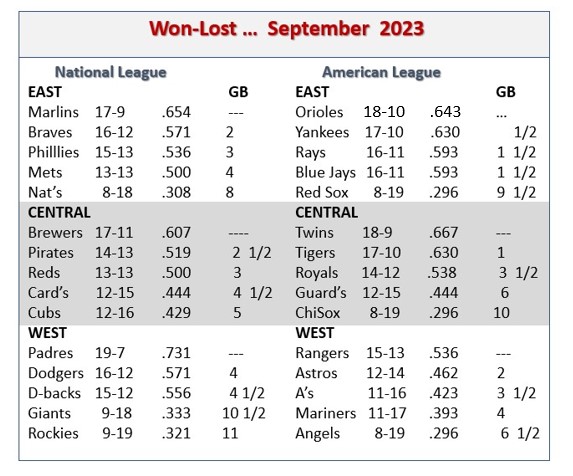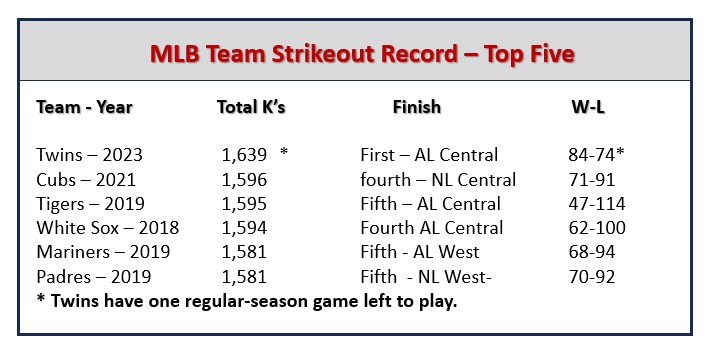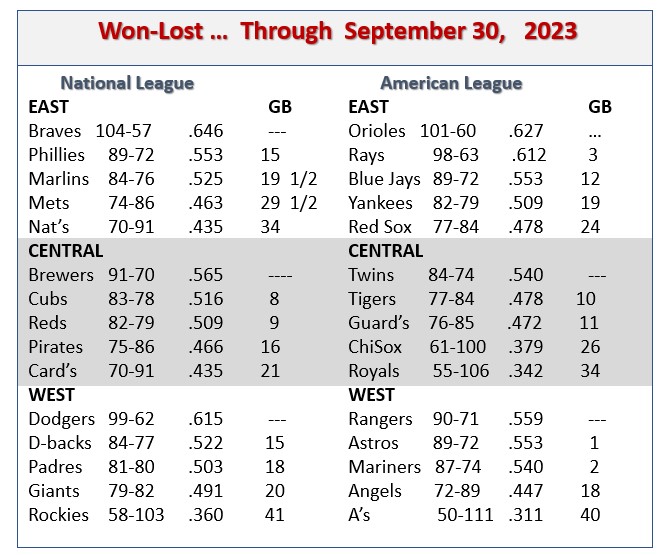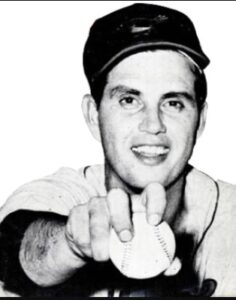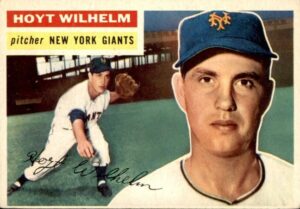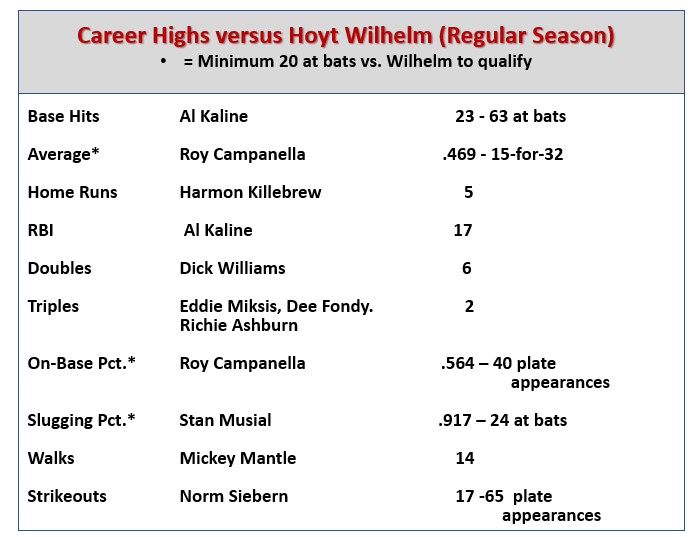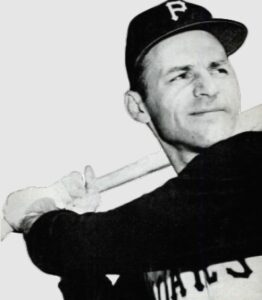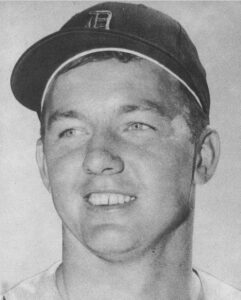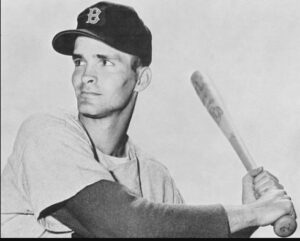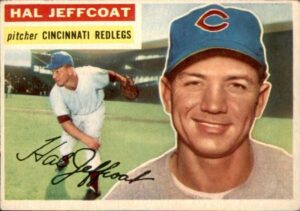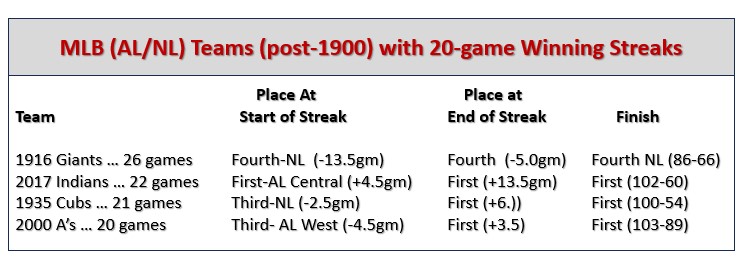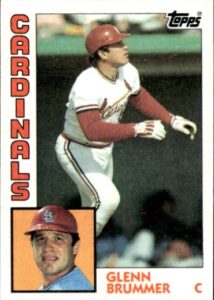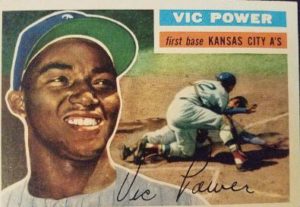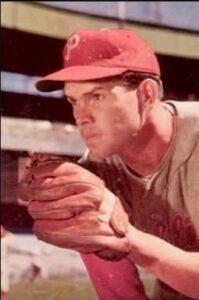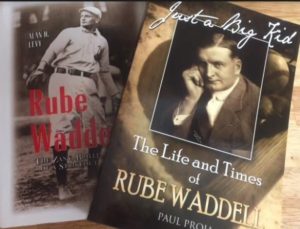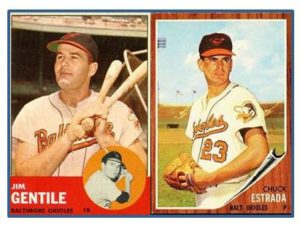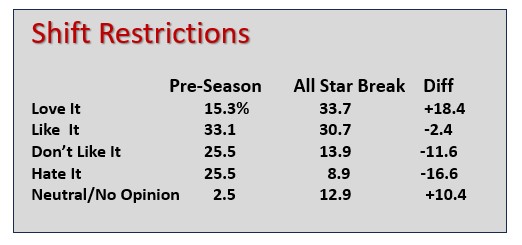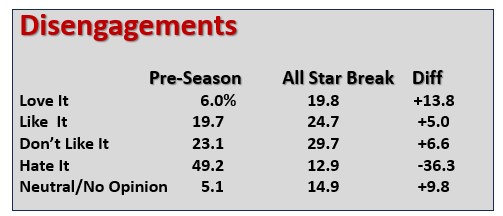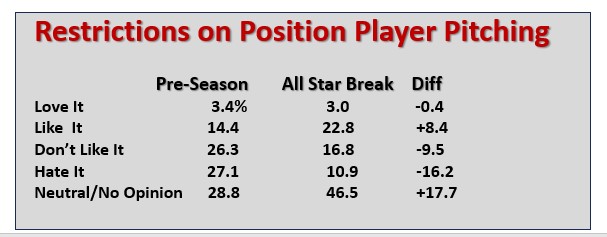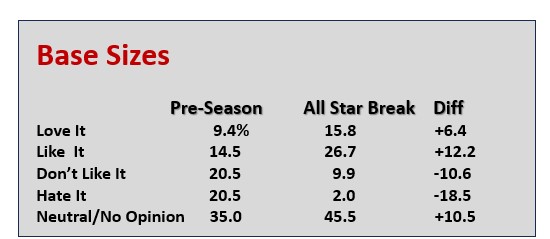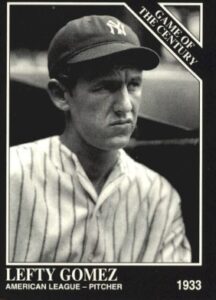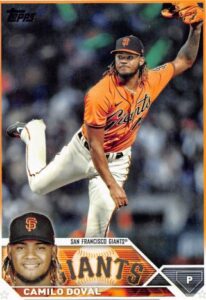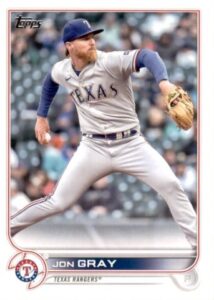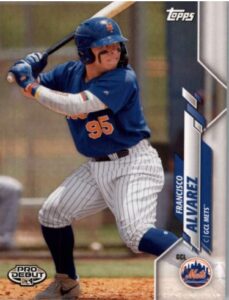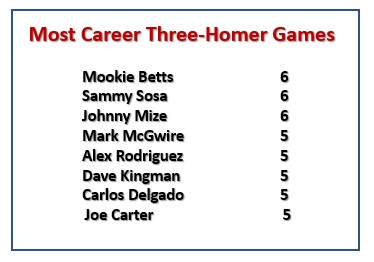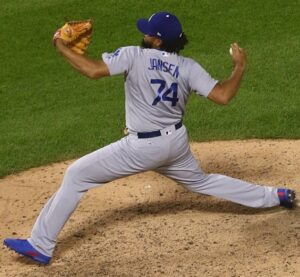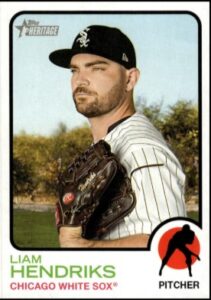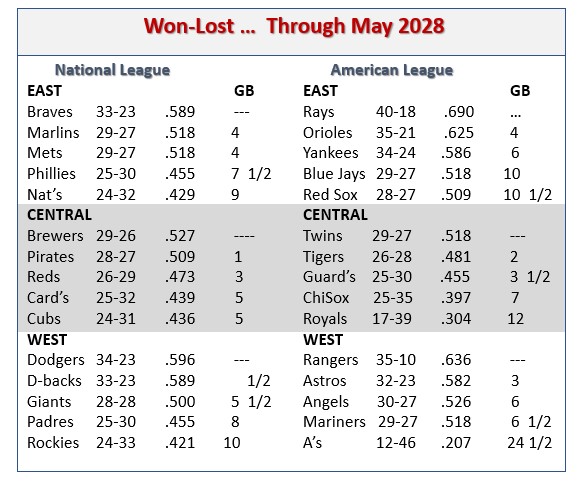It’s October 1, and that means it’s time for the Baseball Roundtable monthly Wrap Up for September – a look at the stories and statistics that caught The Roundtable’s attention over the past month, as well as the standings, Roundtable Players and Pitchers of the Month, the Trot Index and more. Keep in mind, the stats presented are for September only and do not include games of October 1.
As usual, there a few things unusual over the past thirty days:
- The first rookie with a 25-50 season and the first-ever 40-70 campaign (HR/SB);
- A 200th career win and a 400th career home run;
- New records set for home runs and RBI out of the leadoff spot;
- A rookie getting on base via hit or walk in each of his first 29 games (streak still active);
- A team holding their opponents hitless for 10+ innings and still losing the contest;
- A player (an infielder no less) connecting for a home run in four consecutive innings ; and
- More.
Read on for these highlights – and the more. As usual, we’ll start with Baseball Roundtable’s Players and Pitchers of the Month.
BASEBALL ROUNDTABLE PLAYERS AND PITCHERS OF THE MONTH
September 2023
NATIONAL LEAGUE
Player of the Month … Xander Bogaerts, SS, Padres

Photo: Casey Aguinaldo, CC BY-SA 4.0 <https://creativecommons.org/licenses/by-sa/4.0>, via Wikimedia Commons
Padres’ SS Xander Bogaerts delivered that “shiny thing” that gets Baseball Roundtable’s attention – a .400+ average. Bogaerts hit .416 in September, leading all MLBers with at least 50 at bats. His 42 base hits also led MLB and he delivered ten doubles (also leading MLB), two triples, four home runs, 13 RBI and 25 runs scored (third in MLB). In addition, he swiped six bases in six attempts. Bogaerts collected hits in all but three of his 24 September games and had 12 multi-hit games. From September 15-20, he had six consecutive multi-hit games, going 14-for-27 (.519). Bogaerts finished September with a .285-19-58 line on the season (19 steals). (Side note: Marlins’ SS Jon Berti hit .417 in September, but his 48 at bats fell just short of The Roundtable’s 50 at bat cutoff.)
Honorable Mentions: Lot of deserving players here. Another Padre, LF Juan Soto hit .340 and led MLB with 29 September RBI (26 games). His ten home runs were third in MLB and his 26 runs scored were second. In addition, he swiped six bags. He gets extra credit for walking more times (18) than he fanned (15). Soto had five three-hit games in September.
_____
Juan Soto had a 36-plate appearance streak – from September 13 to his fifth at bat September 23 – when he did not strikeout.
_____
The Braves’ Ronald Acuna Jr. averaged .343 for the month, scored 29 runs (leading MLB) and delivered 23 RBI. His 11 September homers tied teammate Matt Olson for the MLB high. He also stole 11 bags in 14 tries. A shout out also goes to to Reds’ CF TJ Freidl, who had a .333-7-18 month, and had three September triples as well.
______________________________________
Pitcher of the Month: Blake Snell, LHP, Padres
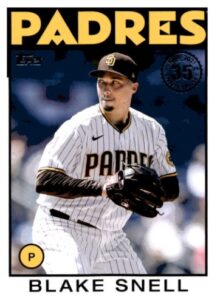 An easy choice. Blake Snell was masterful in September, putting up an MLB-best (among pitchers with at least 20 innings pitched during the month) 0.58 earned run average in 31 innings (and topping the NL in strikeouts with 41). That earned him a 3-0 record in five starts. Snell gave up just 13 hits in his 31 innings (a .123 opponents’ batting average), although he did walk 14. He gave up a run (two actually) in just one of his five September starts. Snell closed out September at 14-9, 2.25 on the season.
An easy choice. Blake Snell was masterful in September, putting up an MLB-best (among pitchers with at least 20 innings pitched during the month) 0.58 earned run average in 31 innings (and topping the NL in strikeouts with 41). That earned him a 3-0 record in five starts. Snell gave up just 13 hits in his 31 innings (a .123 opponents’ batting average), although he did walk 14. He gave up a run (two actually) in just one of his five September starts. Snell closed out September at 14-9, 2.25 on the season.
Honorable Mentions: Braves’ southpaw Max Fried went 3-0, 1.88 in four starts, fanning 27 batters in 24 innings; Marlins’ lefty closer Tanner Scott went 3-1, 1,65, with nine saves in 13 appearances and struck out 20 batters, with just one walk, over 16 1/3 innings.
_______________________________________________________
AMERICAN LEAGUE
Player of the Month – Tie: Jose Altuve, 2B, Astros & Marcus Semien, 2B, Rangers
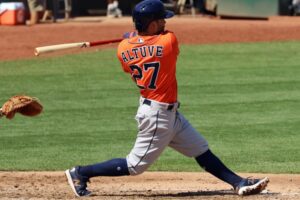
Photo: Jeffrey Hayes, CC BY 2.0 <https://creativecommons.org/licenses/by/2.0>, via Wikimedia Commons
Jose Altuve’s 32 September hits were just one off the American League lead – as he put up a .308-7-17 stat line, with 18 runs scored, in 25 September games. Altuve had ten multi-hit games in September. As September came to a close, Altuve was .312-17-51, with 14 steals in 89 games this season.
On September 5, Altuve went three-for-five, with three home runs (out of the leadoff spot), as his Astros topped Texas 14-1.
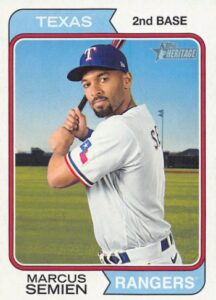 Rangers’ 2B Marcus Semien was an offensive force with .292 average with a league-topping (tied) nine homers, 19 RBI and an AL-highest (tied) September 23 runs scored. Semien had a pair of two-homer games in September. He finished September at .278-29-100, with 14 steals on the season.
Rangers’ 2B Marcus Semien was an offensive force with .292 average with a league-topping (tied) nine homers, 19 RBI and an AL-highest (tied) September 23 runs scored. Semien had a pair of two-homer games in September. He finished September at .278-29-100, with 14 steals on the season.
Honorable Mention: Twins’ rookie infielder Royce Lewis went .313-6-23 in an injury-shortened month.
_______
Pitcher of the Month – Tarik Skubal, LHP, Tigers
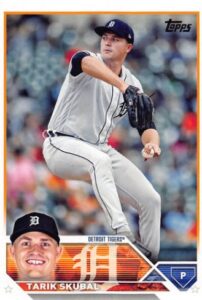 Tarik Skubal went 4-0, 0.90 in five September starts (and, remember, he was pitching for the Tigers). His ERA was second only to Blake Snell among pitchers with at least 20 September innings. He also fanned 43 batters (second only to the Rays’ Tyler Glasnow‘s 48) and walked just four in 30 innings. His 0.60 WHIP was the lowest among pitchers with at least 20 September innings, and he held hitter to a .135 average. In his lone September no-decision, Skubal went four innings, giving up just two hits (no runs), while walking none and fanning eight. He finished September at 7-3, 2.80 (with 15 starts this season).
Tarik Skubal went 4-0, 0.90 in five September starts (and, remember, he was pitching for the Tigers). His ERA was second only to Blake Snell among pitchers with at least 20 September innings. He also fanned 43 batters (second only to the Rays’ Tyler Glasnow‘s 48) and walked just four in 30 innings. His 0.60 WHIP was the lowest among pitchers with at least 20 September innings, and he held hitter to a .135 average. In his lone September no-decision, Skubal went four innings, giving up just two hits (no runs), while walking none and fanning eight. He finished September at 7-3, 2.80 (with 15 starts this season).
Honorable Mentions: Yankees’ RHP Gerrit Cole went 3-0, 1.03 in five September starts , including a two-hit, complete-game shutout (versus the Blue Jays) in his last start.
__________________
Surprise Player of the Month – Reese Olson, RHP, Tigers
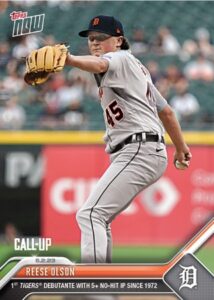 A 24-year-old righty, Reese Olson made his MLB debut on June 2 – called up from Triple-A Toledo (where he was 2-3, 6.38 in ten starts). The 13th Round draft pick (out of North Hall High School in Gainesville, GA,) came into September with a 2-6, 5.10 record, but he turned on the after burners in the season’s final full month – going 3-1, 1.44 in five starts, including a six-inning one-run outing versus the powerful Dodgers. In September, Olson putting up a 0.77 WHIP and held hitters to a .147 average.
A 24-year-old righty, Reese Olson made his MLB debut on June 2 – called up from Triple-A Toledo (where he was 2-3, 6.38 in ten starts). The 13th Round draft pick (out of North Hall High School in Gainesville, GA,) came into September with a 2-6, 5.10 record, but he turned on the after burners in the season’s final full month – going 3-1, 1.44 in five starts, including a six-inning one-run outing versus the powerful Dodgers. In September, Olson putting up a 0.77 WHIP and held hitters to a .147 average.
________________________________________
THE TROT INDEX … A REGULAR BASEBALL ROUNDTABLE FEATURE
Through September, 35.7 percent of the MLB season’s 182,977 plate appearances ended in a trot (back to the dugout, around the bases, to first base). We’re talking about strikeouts, home runs, walks, hit by pitch and catcher’s interference – all outcomes that are, basically, devoid of action on the base paths or in the field. Here’s the breakout: strikeouts (22.7%); walks (8.6%); home runs (3.2%); HBP (1.1%); catcher’s interference (less than 1%). Strikeouts, by the way, outnumbered base hits 41,560 – 40,618.
The 35.7 percent figure is up from 2022’s full season 34.6 percent. Other recent seasons: 2021 – 36.3 percent; 2020 – 37.3 percent; 2019 – 36.2 percent; and 2018 – 34.8 percent. By further comparison, in 1990, the Trot Index was 26.1 percent.
____________________________________
Observations: There were only a handful surprises in September.
First, the AL Central – that nobody seemed to want to win – suddenly came alive. The Twins took charge with an 18-9 month and seemed to be hitting on all four-, six- or eight-cylinders (depending on what kind of car you have). Offensively, they led MLB in runs scored for the month; were third in home runs (second in the AL); first in MLB in on-base percentage and walks drawn; third in total bases (first in the AL). On the mound, they were third in the AL in earned run average (seventh in MLB); second overall (and in the AL) in strikeouts; and gave up the fewest walks in the AL (second in MLB). They had MLB’s (and the AL’s) second-best September strikeouts-to-walks ratio and strikeouts per nine innings. Key contributors were: 3B Royce Lewis (.313-6-23 in just 18 games); RF Max Kepler (.287-3-16); OF/3B Willi Castro (.312, with 18 runs scored) – and the list goes on. In fact, seven Twins had 10+ September RBI and nine scored 10+ runs. On the hill, nine Twins’ pitchers put up ERA’s under 3.00 and seven held hitters to an under .200 average. Don’t count them out in October.
The Tigers surprised a lot of people with their 17-10 month – led by some sterling young pitching: Tarik Skubal (4-0, 0.90 in five starts) and Reese Olson (3-1, 1.44 in five starts) – and an offense driven in part by 24-year-old 1B Spencer Torkelson (.255-7-25 in September) and 40-year-old DH Miguel Cabrera (.324-1-10 during the month). The Bengals also got a .297-5-11 month from C Jake Rogers and twenty runs scored from RF Matt Vierling.
The AL West was a surprise in that only the Rangers were above .500 for the month (15-13) – moving past the Mariners and Astros in a tight race. The Orioles, notching their 100th win are no longer a surprise.
Over in the NL, the Padres had a solid 19-7 September, but their move was too late . Meanwhile the Braves, Brewers and Dodgers played well enough to hold off the competiti0n.
–——Team Statistical Leaders for September 2023 ———-
RUNS SCORED
National League – Braves (160); Cubs (151); Dodgers (147); Padres (146)
American League – Twins (173); Orioles (143); Rangers (143)
The fewest runs in September were scored by the White Sox (82). In the National League, it was the Giants at 92. Also under 100 runs were the Angels (94) and A’s (99).
AVERAGE
National League – Braves (.275); Marlins (.271); Padres (.269)
American League – Astros (.265); Royals (.263); Guardians (.261)
The lowest team average for September belonged to the Angels at .220. The lowest in the NL was the Cardinals (.221).
HOME RUNS
National League – Braves (52); Phillies (46); Reds (43)
American League – Rangers (49); Twins (46); Astros (43)
The Guardians had the fewest home runs in September at 20. The Diamondbacks were at the bottom of the NL at 21.
The Braves led MLB in slugging percentage for at .502. The Astros led the AL at .475.
STOLEN BASES
National League – Phillies (39); Reds (32); Padres (32)
American League – Guardians (38); Royals (31); A’s (25)
The White Sox stole the fewest sacks in Septembers – six in eleven attempts. The Giants were at the bottom of the NL, with 10 in 13 attempts.
WALKS DRAWN
National League – Cardinals (113); Brewers (109); Phillies (107)
American League Twins (125); Rangers (124); Blue Jays (109)
The Twins led MLB in on-base percentage for September at .355. The Reds led the NL at .349. The White Sox had MLB’s lowest OBP for September at .269. The Nationals were at the bottom of the NL at .294. Six of the bottom seven in OBP were from the American League: White Sox; Angels; A’s; Red Sox; Mariners; Yankees.
BATTER’S STRIKEOUTS
National League – Phillies (281); Rockies (264); Pirates (264)
American League – Mariners (274); Yankees (273); Red Sox (272)
Astros’ batters fanned the fewest times in September (181). The Nationals fanned the fewest times in the NL at 195. While the Phillies led MLB in September whiffs, the next five teams were from the AL: Mariners; Yankees; Red Sox; A’s; Angels.
Bonus Stats:
- Braves’ batters racked up the most total bases in July at 499. The White Sox were at the bottom of MLB at 310.
- The Marlins were successful on all 20 of their September steal attempts. The only team with a 100% success rate.
_______________________________________
EARNED RUN AVERAGE
National League – Brewers (2.77); Padres (3.36); Mets (.347)
American League – Tigers (3.00); Orioles (3.30); Twins (3.64)
The Rockies had the highest September ERA at 6.52. Nine teams were at 5.00+ including the Rockies and the Nationals (5.51); Reds (5.49); Braves (5.45); Rangers (5.31); Cardinals (5.23); Pirates (5.14); White Sox (5.08); Royals (5.00).
STRIKEOUTS
National League – Braves (266); Phillies (264); Dodgers (260)
American League – Rays (304); Twins (279); Blue Jays (267)
The Rays averaged an MLB-best 11.15 strikeouts per nine innings in September. The Braves averaged an NL-best 9.54. Fourteen teams averaged nine whiffs per nine or better.
FEWEST WALKS SURRENDERED
National League – Giants (56); Dodgers (71); Diamondbacks (82)
American League – Rays (66); Twins (66); Orioles (67)
The Giants walked an MLB-lowest 2.16 batters per nine innings in September. The A’s walked an MLB-worst 4.73 batters per nine frames.
SAVES
National League – Pirates (10); Braves (10); Marlins (10)
American League – Yankees (11); Guardians (8); Tigers (8); Royals (8); Rays (8)
The Cubs blew the most saves in August – recoding just six saves in 16 opportunities.
Bonus Stats:
- The Braves gave up an MLB-high 47 home runs in September. (Interestingly, the Braves gave up an MLB-low 25 in August). The Mets gave up an MLB-low 42 home runs in September.
- The Brewers held opponents to an MLB-low .202 average in September – after holding opponents to an MLB-low .206 average in August. The Rockies’ staff was touched for an MLB-high .306 average in September.
- The Rays strikeouts-to-walks ratio for September topped MLB at 4.61. The A’s had MLB’s worse ratio at 1.65.
–—-SEPTEMBER 2023 HIGHLIGHTS —–
A First (homer) on the First (swing) of the First (at bat) . which happened to be on the on the First (of the month)
Twenty-year-old switch-hitting Jasson Dominguez made his MLB debut on September 1, playing CF and batting fifth for the Yankees (playing in Houston). His first MLB at bat came against none other than three-time Cy Young Award winner Justin Verlander. After letting a first pitch curve go by for a strike, he took is first MLB swing at Verlander’s next offering – a 94 mph fastball – and smacked his first MLB home run.
Dominguez, by the way, was heralded as a five-tool player ranked as the Yankees’ second-best prospect. In his first eight games with the Yankees he hit .258, with four home runs and seven RBI. However, a scan on September 10 revealed an arm injury that required Tommy John surgery and he is now out for nine-to-ten months.
It Took Two Days, but it Was Worth It

Photo by Keith Allison 
This highlight started in the ninth inning of the Astros’ September fifth 13-6 win over the Rangers in Texas. Astros’ 2B Jose Altuve, who had already gone deep in the sixth inning, finished off the Astros’ scoring with a solo home run off Martin Perez in the top of the ninth.
Fast forward to the very next day – Astros at Rangers again. Altuve led off the first inning with a home run off Nathan Eovaldi. He homered again the second inning (a solo shot with one out) off Eovaldi. Then, he added a homer in the third inning, this time a two-run shot off Dane Dunning. According to the Elias Sports Bureau, that made Altuve the first player in the “Expansion Era” (since 1961) to homer in four consecutive innings. More “InBaseballWeCountEverything.” Altuve also tied the MLB record with five homers in a two-game span.
A Nice Round Number
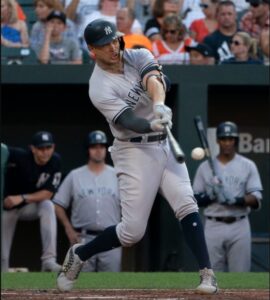
Photo: Keith Allison from Hanover, MD, USA, CC BY-SA 2.0 <https://creativecommons.org/licenses/by-sa/2.0>, via Wikimedia Commons
On September 5, as the Yankees topped the Tigers 5-1, in New York, Yankee DH Giancarlo Stanton broke up 1-1 tie with a two-run homer in the bottom of the sixth. It was the 22nd long ball of the season for Stanton and the 400th of his 14-season MLB career. Stanton is a five-time All Star, the 2017 National League MVP (Marlins). He has hit 30+ homers in seven seasons (a high of 59 in 2017), led the league in homers twice and drove in 100 or more runs in three campaigns.
Let’s Get This Party Started
Angels 1b/1B Nolan Schanuel was the 11th overall pick in the 2023 MLB Draft (after putting up a .386-46-176 stat line in three college seasons at Florida Atlantic). Forty days and 22 minor-league games later, he was in the big leagues – and he’s not slowing down a bit. He made his debut August 18 and quickly ran off a ten-game hitting streak to start his MLB career. His first hitless game came on September 1, but he got on base via a walk in that contest, In fact, as of September 29, he had appeared in 29 MLB gams and been on base via hit or walk in every one. His 2023 stat line as of September 30 – 29 games, .275-1-6, with 19 runs, 20 walks and 19 strikeouts.
Happy Birthday, Joey!
On Sunday, September 10, Reds 1B Joey Votto celebrated his fortieth birthday in style – leading off the eighth inning with a home run off the Cardinals’ Andrew Suarez (part of a 7-1 Reds Win in in St. Louis). It was Votto’s 14th long ball of the season and the 356th homer of his 17-season MLB career. Votto is a six-time All Star and was the 2010 National League MVP.
A Tough Way To Lose
On September 10, three Brewers hurlers (Corbin Burnes, Devin Williams, Abner Uribe) held the Yankees not just scoreless – but hitless – over the first ten innings at Yankee Stadium. The Brewers, however, had managed just three hits and no runs.
The Brewers scored in the top of the eleventh – a single plating that “placed” runner. (Don’t even get me started on that.) The Yankees also plated their gift runner in the bottom of the inning.
Each team scored twice in the twelfth, before the Yankees finally won it 4-3 in the thirteenth – with five of the seven total runs scored being ‘gifted” baserunners.” (Okay, that got me started.)
And a Happy Birthday to you, too, Freddie!
Dodgers’ 1B Freddie Freeman turned 34 on September 12th, but he didn’t show his age. In an 11-2 Dodgers win against the Padres (in LA), Freeman went four-for-five, with a homer, a double, four runs scored and two RBI. It was the fourth time Freeman has gone yard on his birthday – one shy of the MB record (more #InBaseballWeCountEverything).
It’s A Grand Old Game
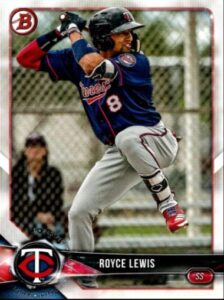 On September 15, Twins’ 24-year-oold rookie infielder Royce Lewis laced a second-inning Grand Slam off of The White Sox’ Jesse Scholtens – breaking a 0-0 tie and starting the Twins toward a 10-2 victory in Chicago. And the Grand Slam was one of the record books.
On September 15, Twins’ 24-year-oold rookie infielder Royce Lewis laced a second-inning Grand Slam off of The White Sox’ Jesse Scholtens – breaking a 0-0 tie and starting the Twins toward a 10-2 victory in Chicago. And the Grand Slam was one of the record books.
- It was Lewis fourth grand slam in 18 games – shortest span of games for four Grand Slams in MLB history;
- It gave Lewis a share of the record for most Grand Slams by a rookie in a season;
- It gave Lewis the Twins’ franchise record for Grand Slams in a season.
Here a list of Lewis 2023 Grand Slams:
August 27, sixth inning – off the Rangers’ Chris Stratton;
August 28, second inning – off the Guardians’ Xzavion Curry (gotta be the only MLBer whose first name starts XZ);
September 4, second inning – off the Guardians’ Lucas Giolito;
September 15, second inning – off the White Sox’ Jesse Scholtens.
Side Note; Lewis also had a Grand slam in 2022, when he played only 12 games (keeping his rookie status intact), giving him five Grand Slams in his first 66 MLB games,
Lewis, hampered by injury concerns, finished the 2023 season with a .309-15-52 stat line in just 58 games.
Sometimes It’s Not So Grand
When Twins’ C Ryan Jeffers watched a called third strike from Angels’ righthander Andrew Wantz – in the second inning of a Twins 9-3 win over the Angels on September 24, it marked a not so grand MLB moment. It was the Twins hitters’ 1,597th strikeout of the season – setting a new MLB single-season record. Notably, the Twins winning record this season is the exception, rather than the rule, among MLB’s top swing-and-miss teams.
A Braves New World
On September 16, as the Braves lost to the Marlins 11-5 in Miami, Braves’1B Matt Olson went two-for-three with a home run . It was his 52nd long ball of the season and gave him the Braves franchise single-season record for home runs (topping Andruw Jones … 51 in 2005). Olson, finished September with a .282-54-137 stat line (all career highs). In fact, with one game left to play, Olson had reached career highs in hits, runs scored, triples, homers, total bases, RBI and average. Note: On September 28, Olson drove in his 135th and 136th runs of the season, setting a modern-era (post 1900) franchise record for RBI (topping Eddie Mathews 135 in 1953).
The Time is WainwRIGHT
On September 18, Cardinals’ righthander Adam Wainwright – in his 18th MLB season – came into his start against the Brewers with a sore right shoulder and a back impacted by the wear and tear of more than 2,500 MLB innings. He had 199 MLB wins and a career 3.54 earned run average on his resume – but a 4-11, 7.95 record on the 2023 season. On this day, Wainwright captured some of the old magic. He pitched seven strong innings (his longest start of the season), gave up just four hits (two walks) and held the Brewers scoreless (his first scoreless outing of the season) – as his Cardinals won 1-0.
The win, Wainwright’s 200th MLB victory – proved to be his final MLB win. A few days later, Wainwright, who had already given notice that this would be his last season in uniform – confirmed that his back and shoulder issues would prevent him from taking the mound again begore retirement. (For trivia buffs, his last pitch was a 2-2 curveball to Brewers’ 3B Josh Donaldson (that Donaldson it for a flyout to center).
In the five seasons from 2009-214, Adam Wainwright went 92-50, 2.83 in 165 starts.
Wainwright will retire with a 200-128, 3.53 record. A three-time All Star, he twice led the NL in victories, owns a pair of Gold Gloves and three times finished in the top three in Cy Young Award voting. As a hitter, he homered on the very first pitch he ever saw (from the batter’s box) off the Giants’ Noah Lowry on May 24, 2006). He went on to hit .193, with ten homers and 75 RBI in 742 career at bats. For trivia buffs, what appears to be Adam Wainwright’s last MLB appearance was as a pinch hitter (in front of a Cardinals home crowd) in the sixth inning of a September 29 game against the Reds. He hit for DH Luken Baker (in the cleanup spot) and grounded out against Brandon Williamson. (At the time, the Cardinals trailed 14-2.)
The Zero Heroes
September saw three complete-game shutouts.
September 8 – Zac Gallen, Diamondbacks, in a 1-0 win over the Cubs in Chicago. Gallen used 107 pitches, giving up three hits, walking one and fanning nine.
September 11 – Brian Woodruff, Brewers, in a 12-0 win over the Marlins in Milwaukee. Woodruff used 106 pitches to toss a seven-hitter, with one walk and seven whiffs.
September 27 – Gerrit Cole, Yankees, in a 6-0 win over the Blue Jays in Toronto. Cole used 105 pitches, gave up two hits, walked none and fanned five.
Through September there were 21 single-pitcher shutouts in MLB. In 2022, there were 16.
Taking This Twins Thing Seriously
On September 17th Twins manager Rocco Baldelli and his wife Allie added to their family with the birth of – of course – twins (both boys).
A Rookie First
On September 20, as the Diamondbacks topped the Giants 7-1 in Arizona, D-back’s rookie Corbin Carroll – starting in RF and leading off – had a big day. He went four-for-five, with a home run, three runs scored and two stolen baes. Not only did he lead the D-backs to a win, but he also hit his 25th homer of the season and stole his 49th and 50th bases – making him the first AL/NL rookie ever with a 25-50 season.
Another National Leaguer Goes “Clubbing”
On September 22, as the Braves topped the Nationals 9-6 in Washington D.C., Braves’ RF Ronald Acuna Jr. clubbed his 40th home run of the 2023 season. (He went two-for four, with a homer, double, hit-by-pitch, three runs scored and one RBI in the game). At the time, Acuna also had 68 stolen bases (in 81 attempts). In the process, he became just the fifth member of the unique 40-40 club (forty homers and at least forty steals in the same season – joining Joe Canseco, A’s (42/40 in 1988); Barry Bonds, Giants (42/40 1996); Alex Rodriguez, Mariners (42/46 in 1998); Alfonso Soriano, Nationals (46/41 in 2006).
With that homer, Acuna also established a new exclusive club – the 40- homer/sixty-steal club. As September closed, they had to rename Acuna’s club the 40-70 Club (41 homers and 73 steals to go with a .338 average).
A Good Year to Lead Off
Ronald Acuna, Jr.’s September 22, home run gave him the record for home runs hit out of the leadoff spot in the lineup in a single season at 40. In September 26, he extended that record to 41. As September closed, the Dodgers’ Mookie Betts had 39 home runs out of the leadoff spot this season, tying for second on the list.
Ditto the Above Headline
On September 23, Dodgers; 2B/OF Mookie Betts smacked a pair of doubles and drove in two runs, as the Dodgers topped the Giants 7-0 in LA. Betts’ two RBI were his 104th and 105th of the season, giving him the single-season MLB record for RBI out of the leadoff spot. Charlie Blackman had held the record at 103 (2017). By September’s end Betts had extended his record to 107 RBI (.306-39-107).
Well, That’s Kind Of Surprising
On September 23, Aaron Judge had a big day versus the Diamondbacks (in New York). Batting second and starting in RF for the Yankees, Judge:
- Doubled off Brandon Pfaadt in the bottom of the first inning;
- Hit a three-run homer to right-center off Pfaadt in the third;
- Hit a two-run homer off Pfaadt in the fifth;
- Hit a solo shot off Slade Cecconi in the seventh.
It was Judge’s second three-homer game of the 2023 season – which is why it is mentioned here. Given a history that includes such sluggers as Babe Ruth, Lou Gehrig and Mickey Mantle, it is surprising that Judge is the first Yankee with two three-homer games in a season. The Yankees, by the way, prevailed 7-1, with Judge collecting six RBI
More #InBaseballWeCountEverything
On September 24, with the Phillies leading the Mets 5-2 (in Philadelphia), the Phils called Mike Lorenzen in from the bullpen in the top of the ninth inning. Two groundouts and a strikeout later, Lorenzen had his first save of 2023. It came in just his second 2023 relief appearance – following 25 starts. Why is it a highlight? On August ninth, Lorenzen pitched a complete-game, no-hitter. The save made him just the tenth pitcher (since saves became an official stat in 1969) to toss a no-hitter and pick up a save in the same season. Other names on the list Bob Moose (1969). Jim Bibby (1973); Nolan Ryan (1973); John Candelario (1973); Jerry Reuss (1976); Chris Bosio (1980); Matt Garza (1993); Tim Lincecum (2010).
They call Him the Streak
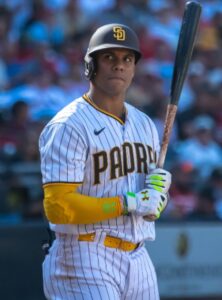
Photo: Soto: Ryan Casey Aguinaldo, CC BY-SA 4.0 <https://creativecommons.org/licenses/by-sa/4.0>, via Wikimedia
Between August 26 and September 27, the Padres’ Juan Soto ran off a streak of 30-games getting on base. During that streak her hit .349 (38-for-109), with 11 home runs, 32 RBI and 27 runs scored., He also drew 23 walks and was hit by a pitch (.463 on-base percentage).
–——Individual Statistical Leaders for September 2023——––
AVERAGE (minimum 75 September at bats)
National League – Xander Bogaerts, Padres (.416); Noelvi Marte, Reds (.387); Seiya Suzuki, Cubs (.370)
American League – Yandy Diaz, Rays (.345); Andres Gimenez, Guardians (.333); Josh Lowe, Rays (.318)
The lowest September average (among players with at least 50 at bats in the month) belonged to Giants’ C Patrick Bailey at .121 (7-for-58).
HOME RUNS
National League – Ronald Acuna, Jr., Braves (11); Matt Olson, Braves (11); Juan Soto, Padres (10); Kyle Schwarber, Phillies (10)
American League – Marcus Semien, Rangers (9); Nelson Valazquez, Royals (9); Logan O’Hoppe, Angels (9)
The Dodgers J.D. Martinez had the highest September slugging percentage (at least 75 at bats) at .724. The AL leader was the Astros’ Yordan Alvarez at .629.
HITS
National League – Xander Bogaerts, Padres (42); Seiya Suzuki, Cubs (40); Ozzie Albies, Braves (38)
American League – Gunnar Henderson, Orioles (33); Marcus Semien, Rangers (33); Jose Ramirez, Guardians (33)
The top seven hitters – in terms of base hits – for September were from the National League.
RUNS BATTED IN
National League – Juan Soto, Padres (29); Seiya Suzuki, Cubs (26); J.D. Martinez, Dodgers (25); Matt Olson, Braves (25)
American League – Jose Abreu, Astros (26); Spencer Torkelson, Tigers (25); Royce Lewis, Twins (23)
The Rockies Nolan Jones led MLB (at least 75 September at bats) players in on-base percentage at .460. The AL leader was the Yankees Aaron Judge at .452.
DOUBLES
National League – Willy Adames, Brewers (10); Xander Bogaerts, Padres (10); Michael Harris II, Braves (10); Marcell Ozuna, Braves (10)
American League – Adley Rutschman, Orioles (9); Anthony Santander, Orioles (9); six with eight
TRIPLES
National League – Brenton Doyle, Rockies (4); TJ Freidl, Reds (3); Nolan Jones, Rockies (3)
American League – Kyle Tucker, Astros (4); Gunnar Henderson, Orioles (3); five with two
The Cubs’ Seiya Suzuki and Braves’ Marcel Ozuna led MLB in September extra-base hits with 18. The Orioles’ Gunnar Henderson and Rangers’’ Marcus Semien led the AL with 17.
STOLEN BASES
National League – Corbin Carroll, Diamondbacks (13); Elly De La Cruz, Reds (12); three with 11
American League – Esteury Ruiz, A’s (13); Bobby Witt, Jr., Royals (11); Andres Gimenez, Guardians (8)
The Diamondbacks’ Corbin Carroll stole his MLB-leading 13 bases in September without ever getting caught.
WALKS
National League – Bryce Harper, Phillies (24); Kyle Schwarber, Phillies (24); Nolan Jones, Rockies (20)
American League – Aaron Judge, Yankees (27); Edouard Julien, Twins (24); Andy Rutschman, Orioles (19)
The Astros’ Alex Bregman led in walks/strikeouts ratio (among batters with at least 75 September plate appearances) at 2.00 … 16 walks versus 8 whiffs in 26 games.
BATTER’S STRIKEOUTS
National League – Kyle Schwarber, Phillies (43); Ryan McMahon, Rockies (33); Nick Castellanos, Phillies (33)
American League – Ryan Noda, A’s (45); Teoscar Hernandez, Mariners (40); Eugenio Suarez, Mariners (40)
PITCHING VICTORIES
National League – Spencer Strider, Braves (4-1); Michael Wacha, Padres (4-2); 13 with three
American League – Tarik Skubal, Tigers (4-0); Brito, Yankees (4-1); 20 with three
Leading MLB with four September losses were: John Brebbia, Giants (1-4, 4.82); Hunter Brown, Astros (1-4, 9.14); Griffin Canning, Angels (0-4, 4.13); Carlos Rodon, Yankees (2-4, 8.10)
Right Place Right Time & Vice Versa
The Rangers’ Dane Dunning went 3-0, in five September games (four starts) with a 5.02 ERA. The Yankees Michael King went 1-2 in five starts, with a 1.30 ERA.
EARNED RUN AVERAGE (minimum 25 September innings pitched)
National League – Blake Snell, Padres (0.58); Brandon Woodruff, Brewers (1.67); Logan Webb, Giants (2.02)
American League – Tarik Skubal, Tigers (0.90); Michael King, Yankees (1.30): Reese Olson, Tigers (1.44)
The Royals’ James McArthur threw the most September innings without giving up an earned run (14 1/3). In 11 September appearances, he gave up just hits and no runs, while fanning 15 and not walking a single batter.
INNINGS PITCHED
National League: Zac Gallen, Diamondbacks (36 2/3); Merrill Kelly, Diamondbacks (36 1/3); Logan Webb, Giants (35 2/3)
American League: Justin Verlander (39); Jordan Montgomery, Rangers (36 1/3); Logan Gilbert (35 2/3)
STRIKEOUTS
National League – Blake Snell, Padres (41K / 31 IP); Merrill Kelly, Diamondbacks (40K / 36 1/3 IP); Zac Gallen (38K / 36 2/3 IP)
American League – Tyler Glasnow, Rays (48K / 33 1/3 IP); Nick Pivetta, Red Sox (43K / 33 1/3 IP); Tarik Skubal, Tigers (43K / 30 IP)
SAVES
National League – David Bednar, Pirates (9); Tanner Scott, Marlins (8); three with six
American League – Emmanuel Clase, Guardians (8); Clay Holmes, Yankees (8); Pete Fairbanks, Rays (7)
The Pirates’ David had the most saves without a blown saves in September at nine.
WHIP (Walks + Hits per Inning Pitched – minimum 25 August innings)
National League – Ryan Pepiot, Dodgers (0.76); Brandon Woodruff, Brewers (0.81); Freddy Peralta, Brewers (0.83)
American League – Tarik Skubal, Tigers (0.60); Gerrit Cole, Yankees (0.69); Reese Olson, Tigers (0.77)
The Padres’ Blake Snell (among pitchers with at least 25 September inning) held hitter to the lowest average (.123). In the AL, that honor went to Tarik Skubal of the Tigers at .135.
Random Bonus Stats:
- Lucas Giolito of the White Sox gave up the most September homers (10 in 25 2/3 IP), He went 1-3, 6.66.
- The Yankees’ Gerrit Cole pitched the most September innings without giving up home run – 35.
- The Pirate’s Johan Oviedo walked the most batters in September (19 in 23 1/3 innings).
Primary Resources: Baseball-Reference.com; MLB.com; Baseball-Almnac.com
Baseball Roundtable – Blogging Baseball Since 2012.

 Baseball Roundtable is on the Feedspot list of the Top 100 Baseball Blogs. To see the full list, click here.
Baseball Roundtable is on the Feedspot list of the Top 100 Baseball Blogs. To see the full list, click here.
Baseball Roundtable is also on the Anytime Baseball Supply Top 66 Baseball Sites list. For the full list, click here.
I tweet (on X) baseball @DavidBaseballRT
Follow/Like Baseball Roundtable’s Facebook Page here. Find More baseball commentary; blog post notifications; PRIZES.
Member: Society for American Baseball Research (SABR); Negro Leagues Baseball Museum; The Baseball Reliquary.
P1005
